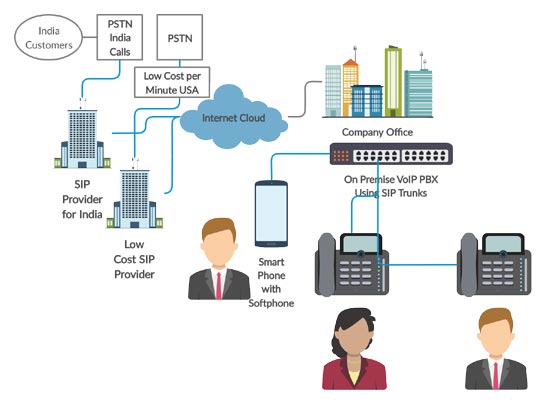SIP trunks are frequently the best phone connection for a PBX.
What are SIP trunks and why are they favored?
 SIP
trunks are virtual connections delivering voice and other
unified communications over the Internet.
Using SIP trunks, SIP (Session Initiation Protocol) providers can connect
a SIP trunk to an on-premise PBX allowing local, long
distance and International calls over the Internet.
SIP
trunks are virtual connections delivering voice and other
unified communications over the Internet.
Using SIP trunks, SIP (Session Initiation Protocol) providers can connect
a SIP trunk to an on-premise PBX allowing local, long
distance and International calls over the Internet.
Each SIP trunk can support a number of SIP channels, frequently referred to as sessions or lines. Each channel (line) provides the capability to maintain one incoming or outgoing call. Consequently, frequently the first question proposed is how many SIP trunks do I need. The answer is one. You merely select the appropriate number of channels. Unless, that is, you prefer multiple providers (We explain some benefits of using multiple providers below), then one trunk per SIP provider.
Configuring your PBX with a SIP trunk provides low-cost, local, long distance and International calls using VoIP. SIP trunking eliminates the need for traditional phone connections and saves companies an average of 70% on their monthly phone bills.1
SIP (Session Initiation Protocol), is the primary protocol employed by the majority of businesses using VoIP to send voice and video communications across the internet.
SIP trunks are virtual phone connections that link a business IP-PBX to the PSTN through a provider. These virtual phone lines allow you to place and receive phone calls anywhere in the world using a telephone number, whether employing VoIP (Voice over Internet Protocol) or the PSTN (Public Switched Telephone Network) or a combination of both.
The SIP provider furnishes the virtual phone lines and then connects and establishes each voice phone call. The line can connect to the PTSN or remain completely over the Internet to a VoIP device. Many users who generate considerable calls choose to pay based on their call volume or what's referred to as a metered plan.
SIP trunks remain the number one way to provide low-cost VoIP phone services to an existing IP-PBX.
SIP trunks remain considerably lower in cost than traditional types of phone services. Businesses regularly reduce phone calling costs by utilizing low cost "unlimited" plans or by employing "pay by the minute plans" using low bulk rate minutes. Some SIP trunk providers offer particularly low rates to specific regions or countries.
Businesses that generate a considerable number of International calls have come to recognize the advantages of employing a number of providers. The IP-PBX is configured using outbound rules to select the lowest cost provider. By employing numerous providers, companies can easily setup a very cost-effective redundant call center utilizing an on-premise IP-PBX.
 Call
centers can incorporate multiple SIP Providers to maximize cost savings
and Redundancy
Call
centers can incorporate multiple SIP Providers to maximize cost savings
and Redundancy
SIP trunk services are significantly less expensive than traditional business telephone lines. Sometimes 60% to 75% lower.
The number of SIP channels required by a business frequently depends on its business model and the amount of call activity they undertake. Selecting providers is determined by the provider's strengths, like reliability and their particular call rates. For example, one provider may retain low priced virtual routes for calls to Ghana, while another may possess the lowest call rates to Brazil. 8x8 has been recognized for exceptionally favorable rates for International calls and has been favored by many call centers.
The term "trunk" goes back to the early telephone days. When used today with SIP it doesn’t apply to a physical collection of wires; rather, the trunk represents a combination of “virtual” lines.
By employing multiple SIP providers, call centers often achieve distinct cost saving advantages.
Several niche SIP providers regularly maintain specialized reduced cost call rates, which makes them an attractive choice for that particular country or locale. It's accurate that one SIP trunk is capable of an unlimited number of channels. However, incorporating several SIP trunks, each from a different niche provider enables businesses to maximize benefits by configuring lowest cost call rules. Plus, using multiple providers facilitates redundancy in case a provider temporarily experiences problems.
Leveraging SIP Trunks with PBX Systems: Enhancing Communication Efficiency
Unlocking PBX Potential with SIP Trunks
Many modern PBXs, especially IP-PBXs, offer the flexibility to integrate SIP trunk connections as primary or secondary phone services. If your PBX was deployed within the last decade, it's highly probable that it already supports SIP, thereby transforming your in-house PBX into a versatile VoIP phone system.
Tailoring Capacity to Office Needs
The allocation of SIP lines correlates closely with office size and call volume. For instance, a small office with three employees typically requires one line per person, assuming simultaneous calls. However, as the office expands, the lines-to-employees ratio decreases to around sixty percent. Call-intensive environments, like call centers, demand a higher trunk-to-employee ratio to ensure seamless call handling and optimize performance.
Advantages of SIP Trunks Integration:
- Cost Efficiency: SIP services typically offer significant cost savings compared to traditional TDM circuits. Businesses can select SIP providers offering competitive rates for inbound and outbound calls, customized by region or country.
- Enhanced PBX Functionality: SIP trunks empower on-premise PBX systems to leverage VoIP technology for communication, enabling seamless integration with Internet-based communication channels.
- Budget-Friendly Unlimited Plans: Many SIP providers offer cost-effective unlimited plans, encompassing a wide range of minutes within a fixed monthly fee, often covering extensive geographical areas.
- Scalability and Flexibility: Adding or increasing trunks and channels is straightforward, ensuring rapid scalability to accommodate evolving business needs. Additionally, SIP trunks offer unmatched flexibility, handling an unlimited number of concurrent calls.
- Multi-Carrier Compatibility: Businesses can configure multiple SIP trunks to leverage various SIP providers within a single IP-PBX, enhancing flexibility and redundancy.
- Seamless Conference Bridging: Transitioning audio conferencing services to SIP trunking eliminates long-distance charges and facilitates seamless communication, enhancing collaboration efficiency.
- Disaster Recovery Capabilities: SIP trunking enables instant call rerouting and offers failover options in case of provider downtime, ensuring uninterrupted communication during emergencies.
- Efficient Resource Utilization: SIP trunks leverage existing Internet connections, dynamically allocating bandwidth for voice calls while optimizing resource usage for other applications.
- Reduced Maintenance: Eliminating the need for PSTN or PRI hardware, copper lines, and circuit boxes streamlines maintenance efforts, reducing costs and complexity
In summary, integrating SIP trunks with PBX systems offers a plethora of benefits, ranging from cost efficiency and scalability to enhanced functionality and disaster recovery capabilities, making it a strategic choice for modern businesses aiming to optimize communication infrastructure.
Establishing a SIP trunk connection on an IP-PBX is straightforward. Providers routinely include online instructions and offer guidance.
 Some PBXs and most IP-PBXs include the ability to add SIP trunk
connections as the primary or a secondary phone service. If your PBX
system was constructed within the last ten years, it is likely at present
SIP enabled. By including one or more channels from
a SIP provider, an in-house PBX transforms into a VoIP phone system.
Some PBXs and most IP-PBXs include the ability to add SIP trunk
connections as the primary or a secondary phone service. If your PBX
system was constructed within the last ten years, it is likely at present
SIP enabled. By including one or more channels from
a SIP provider, an in-house PBX transforms into a VoIP phone system.
Typically, a small office with three people would require one "line" per
person, if all three were on the phone at the same time. As
office size increases the ratio of lines per person would likewise decrease to
approximately
sixty percent. Call centers and high call volume businesses would
naturally require a
high ratio of trunks or active virtual phone lines to working employees.
This ensures every active agent has a line available at all times, maximizing
call performance.
The Greatest Flexibility and Control for Call Centers
SIP trunks offer the most flexibility of any phone service. The precise nature of SIP allows for multiple trunks from numerous providers to be added or subtracted instantaneously. This instant flexibility provides concise control by scaling trunks from various SIP providers, as needed, selecting the most cost-effective and advantageous companies.
Benefits of SIP trunks include:
Scalability
Flexibility
Lower Cost Calling
DR - Instantly Redirect Calls
Connect Multiple Locations
SIP vs. VoIP
Voice over Internet Protocol refers to the protocols that enable voice-based phone calls to be established over the Internet rather than through the PSTN via a local telephone provider.
SIP and VoIP are not exactly interchangeable, although many times they are used jointly. VoIP (Voice over Internet Protocol) represents a broad term covering phone calls placed over the Internet. Included in VoIP is SIP (Session Initiation Protocol), only one of the specific protocols that enable VoIP.
Bandwidth Requirements
For a small office, a reasonable rule of thumb is about 90 Kbps for each active call for both download and upload. That's using a high quality uncompressed G.711 codec. Employing G.729 compression to reduce bandwidth voice would utilize about 32 Kbps; however, G711 remains the most utilized high quality narrowband codec. Another codec, the wideband G.722, regularly ends up producing voice quality as good as G.711 and occasionally exceeds it with the finest voice quality overall. Mean Opinion Score (MOS) ratings; a common assessment of voice clarity typically determines G.711 at 4.4 and G.722 at 4.5, so not really a sizable difference. When deciding which codec is best for your situation, it's often advisable to discuss your particular needs and Internet capabilities with the provider. Frequently upload bandwidth is less than download bandwidth; therefore, it's prudent to calculate the number of simultaneous calls based upon it.
Conclusion
 The choice between a
cloud-based business
phone service (aka hosted VoIP) and an on-premise IP-PBX using SIP trunks
is often guided by the size of the company and number of calls.
Typically, small companies or offices with up to about 20 employees
might appreciate how easily managed hosted VoIP solutions have become, especially when employing at-home
or remote workers. However, as the
number of employees and the need for SIP trunks (lines) increase, an on-premise IP-PBX
frequently delivers advantages in cost efficiencies with added
flexibility and control.
The choice between a
cloud-based business
phone service (aka hosted VoIP) and an on-premise IP-PBX using SIP trunks
is often guided by the size of the company and number of calls.
Typically, small companies or offices with up to about 20 employees
might appreciate how easily managed hosted VoIP solutions have become, especially when employing at-home
or remote workers. However, as the
number of employees and the need for SIP trunks (lines) increase, an on-premise IP-PBX
frequently delivers advantages in cost efficiencies with added
flexibility and control.
Companies
using SIP trunks can employ multiple SIP service providers choosing
routes based on specific rates, time of day and country. Additionally,
by maintaining complete control of the IP-PBX and using preferred codecs
plus SD-WAN software, a company can increase the number of simultaneous
calls using less bandwidth. This flexibility is frequently
consequential.
One consideration when installing an on-premise VoIP
PBX would be employing personnel capable of administering the appliance.
Most SIP providers do offer easy setup instructions and assistance. And they
frequently provide phone support for
configuration or troubleshooting technical issues.
Office to Office Free Calling
Incorporating a peer-to-peer SIP trunk between multiple offices provides free Peer-to-Peer calls. Companies regularly set up extension dialing between offices, regardless of where they are physically located. Connecting multiple sales offices worldwide can save you thousands of dollars.
If you currently have your own on-premise PBX phone system, then it likely possesses SIP trunk capabilities. There is no better way to turn your phone system into a VoIP phone system than by incorporating SIP trunks. Setting up a SIP trunk connection remains a worthwhile endeavor. By opening up a lower cost phone service, you can significantly reduce your phone call expenses. And even if your PBX does not have the ability to connect via SIP, you can still use a SIP trunk by employing an Analog Telephone Adapter (ATA) or a SIP-ISDN gateway.
Growth of SIP Trunking Forecast
The global SIP trunk services market size is was estimated at $13.87 billion in 2023 and is expected to reach $43.74 billion by 2031.1
Global SIP trunk services market size will continue growing, especially now due to the ongoing changes in work environments.
SIP trunks provide the mechanism for companies, especially multi-national enterprise-level corporations, to eliminate obstacles between people engaging in different communication modes globally through media and various devices.
This article was originally published under "What is a SIP trunk?". Since that time it has been completely rewritten, updated and revised.
References and Resources
1Transparancy Market Research-
SIP Trunking
Services Market
Sip Trunking Basics-
siptrunk